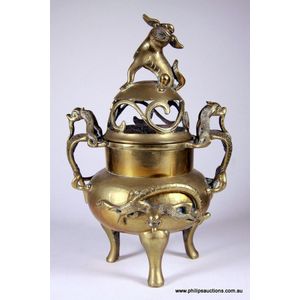Satsuma Lacquer Sake Set with Cinnabar Box
You must be a subscriber, and be logged in to view price and dealer details.
Subscribe Now to view actual auction price for this item
When you subscribe, you have the option of setting the currency in which to display prices to $Au, $US, $NZ or Stg.
- Finial - An architectural decoration, found on the upper parts of of an object. On furniture they are usually found on pediments, canopies and shelf supports. On smaller ceramic or silver items, such as spoons, they may decorate the top of the item itself, or the lid or cover where they provide a useful handle for removal.
Finials have a variety of shapes and forms. They may be urn-shaped, baluster shaped round or spiral, but usually taper into an upper point. Many real life shapes may also be used as finials, such as pineapples, berries, pinecones, buds, lotus and acorns. Sometimes animals such as a lion are depicted, or fish and dolphins. - Lacquered Lacquerware - Lacquer is a clear or coloured resin that is obtained from the sap of several species of trees in the genus Rhus, particularly the Rhus verniciflua tree, which is native to China and Japan. The resin is harvested by making incisions in the tree bark and collecting the sap that oozes out.
The sap is then processed and refined through a series of steps, which may include filtration, heating, and chemical treatments. The resulting lacquer is a highly durable and glossy material that is used as a finish for furniture, musical instruments, and other objects.
Lacquer has been used for thousands of years in Asia, where it is valued for its beauty and durability. It is applied in multiple thin layers, with each layer being allowed to dry and harden before the next one is added. The process can take several weeks or even months to complete, but the resulting finish is incredibly hard, glossy, and resistant to scratches and wear.
The lacquer derived from the resin of the Rhus tree has been used for decoration of furniture in several countries in Asia, particularly China, Japan, Korea, and Vietnam. These countries have rich traditions of using lacquer for furniture decoration and have developed unique techniques and styles of lacquer work.
In China, lacquer has been used for furniture decoration for over 2,000 years, and it became a major art form during the Ming (1368-1644) and Qing (1644-1912) dynasties. Chinese lacquerware is known for its intricate carving, painting, and inlay work, as well as its use of bold colours and designs. Lacquer was used to decorate furniture such as cabinets, screens, and chairs.
In Japan, lacquer has been used for furniture decoration for over 1,000 years. Japanese lacquerware is characterized by its simplicity and elegance, and it often incorporates natural materials such as wood, bamboo, and shells. Lacquer was used to decorate furniture such as chests, cabinets, and trays.
In Korea, lacquer has been used for furniture decoration for over a thousand years. Korean lacquerware is known for its restrained and understated beauty, and it often features delicate patterns and designs that are achieved through careful layering and carving. Lacquer was used to decorate furniture such as cabinets, chests, and screens.
In Vietnam, lacquer has been used for furniture decoration for over 2,000 years. Vietnamese lacquerware is known for its vibrant colours and intricate designs, and it often features scenes from daily life, nature, and mythology - Cinnabar - Cinnabar is an intense deep red colouring agent that has been in use for thousands of years, derived from crystalised red mercuric suphide. It is made into a coating by grinding ore into a fine powder then mixing the powder with lacquer made from the sap of the Rhus tree, which grows in East Asia.
As applied to Oriental antiques, cinnabar refers to successive layers of laquer applied to the metal base of an object. Once the coating has dried and hardened, a further layer is applied. The layers continue to be applied until the thickness is 3 to 6 mm, and this may take up to 200 to 300 coats. At this stage, the surface is ready for the carving, that is characteristic of cinnabar items.
Because of the labour required, cinnabar items are usually small, such as vases, boxes, trays and snuff bottles.
However buyers should be aware that the cinnabar technique has been copied using modern plastic type materials that are moulded rather than carved. A close examination of a genuine cinnabar item under a strong magnifying glass or jewellers loupe should show evidence of the many layers that make up its thickness, and possibly tool marks left by the carver.
This item has been included into following indexes:
- Japanese ceramics, item types - other 2,591
- oriental objects - Japanese sake pots, bottles and cups 32
-
Satsuma (Japan), item type
- boxes 111
- figures and figurines 224
Visually similar items

A George IV sterling silver soup tureen and cover, Richard Sibley, London 1822 the tureen of oval form with a gadrooned rim and elaborate acanthus and shell motifs to the handles, raised on four paw feet, the domed cover with applied chasing, gadrooned and

A Chinese cloisonne and bronze tripod censer, the lobed ovoid censer with a conforming domed lid and a pierced top section with a cast and pierced finial, shaped and pierced bracket handles with lingzhi mushroom embellishments, similar mounts to the tripod

A Chinese bronze covered censer, Republic Era, mid 20th century, the compressed cauldron style pot raised on three shaped legs with a wide collar and pierced dome lid with a lion dog finial, with bearded dragon handles and applied fantastic creatures to th

A bronze Chinese censer, early to mid 20th century, of ovoid form raised on zoomorphic tripod feet and with chilong handles, and having a pierced dome with a dog of fo finial, the body with ruyi carrying horse riders surrounded by coins, possibly the image
